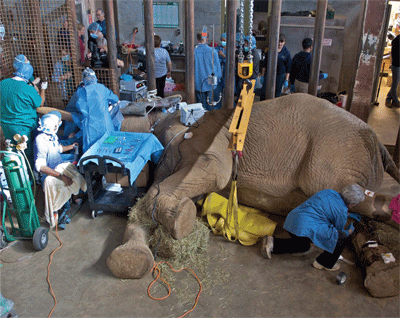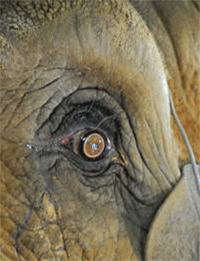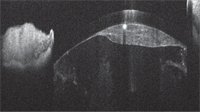The North Carolina Zoo’s longest resident, a 38-year-old African elephant named C’sar, had been suffering from deteriorating vision since 2010 due to cataracts in both eyes. His condition became so bad that he was taken out of the elephant exhibit for his own safety, and sheltered within his barn and paddock since March 2011, out of the public eye.

Imagine comanaging care for this critter. C’sar, a 38-year-old pachyderm, undergoes a four-hour cataract procedure in the North Carolina Zoo’s elephant barn.


This SD-OCT image (above) of C’sar’s
cataract chronicles the first time spectral domain was used on an elephant.
Veterinary ophthalmologists had hoped to implant a specially created artificial lens in C’sar’s eye, but damaged tissue could not support it. It would have been the first artificial lens implantation ever performed on an elephant.
But in November 2011, the well-known pachyderm successfully underwent cataract surgery in his left eye, thanks to a team of specialists from the N.C. State University College of Veterinary Medicine.
Led by Richard J. McMullen, Jr., D.V.M., assistant professor of ophthalmology, the four-hour procedure was the fifth cataract surgery performed on an elephant anywhere in the world. It also marked the first time spectral-domain optical coherence tomography was used on an elephant.
The surgery team utilized a specialized ophthalmic imaging system, the Envisu R2300 [Bioptigen], the only commercially available ophthalmic SD-OCT system with a hand-held scanner.
Unfortunately, the surgery left C’sar aphakic. Because of damaged tissue caused by the cataract, the elephant’s eye would not have provided enough support for the specially-created artificial lens that Dr. McMullen had intended to implant.
Although C’sar’s vision is now improved after cataract removal, he’ll be farsighted without the implant in that eye.
Nevertheless, “C’sar’s surgery was highly successful and has dramatically improved his quality of life, even without the replacement lens,” says Guy Lichty, the zoo’s mammal curator.
The zoo staff looks forward to allowing C’sar to return to a larger exhibit space once the weather and his recovery allows it. But if the elephant still has problems safely negotiating the space, “we’ll have to discuss perhaps operating on his other eye in hopes of further improvement,” Mr. Lichty says.

